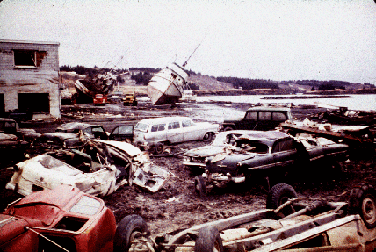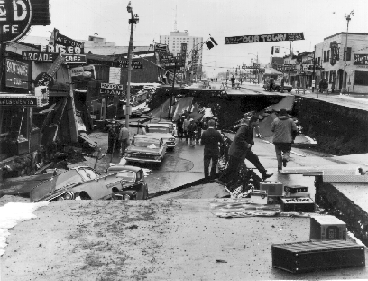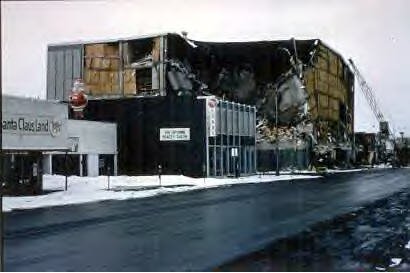ALASKA
Prince William Sound, Alaska,
earthquake
of March 27, 1964.
PHOTOGRAPHS

The Alaskan earthquake
generated a tsunami which destroyed this
waterfront in Kodiak.
In addition, the
earthquake caused a city street in Anchorage to collapse.
Photos courtesy of USGS.
J.C. Penney Building in Anchorage (Photo credit: NOAA/NGDC)
|
ALASKA The Alaskan earthquake occurred on Good Friday, March 27, 1964, at 5:36 PM local time. It was the largest earthquake ever recorded in North America. Duration estimates range from 3 to 5 minutes. Sources vary as to the magnitude of this earthquake, in part because a variety of scales are used to measure earthquakes. Bruce Bolt lists it as 8.6 Ms, where Ms is the surface-wave magnitude. The USGS gives it a 9.2 Mw, where Mw is the moment magnitude. |
EPICENTER The epicenter was located between Valdez and Anchorage, near Prince William Sound. The earthquake occurred on a thrust fault. This fault was a subduction zone, where the Pacific plate plunges underneath the North American plate. The first slip occurred at a depth of 25 km (16 miles), which is a shallow depth |
|
TSUNAMI The sudden uplift of the Alaskan seafloor caused a tsunami, which was responsible for 122 of the 131 deaths. The tsunami propagated at speeds over 400 miles per hour. The tsunami also struck Crescent City, California,
killing ten people. Giant redwood logs from a nearby sawmill were
thrust into the city streets. Seiches occurred in rivers, lakes, bayous, and protected harbors and waterways along the Gulf Coast of Louisiana and Texas, causing minor damage. Note that a seiche is a sloshing of water back and forth. |
|
HARBOR WAVES As landslides cascaded into the sea, they generated gigantic harbor waves that smashed upward against the shore, in some places as high as 100 feet above normal tide levels, per Reference 3. |
|
ANCHORAGE The earthquake also caused ground liquefaction, whereby the soil and sand temporarily turned from a solid to a liquid state. Rockslides and avalanches occurred as a result of the liquefaction. Some of the landslides occurred in Anchorage, particularly at Turnagain Heights. Soft clay bluffs at this location collapsed during the strong ground motion. About 75 homes were thus destroyed. The property damage cost was about $311 million. Much of the property damage occurred in Anchorage. For example, the J.C. Penney Company building and the Four Seasons apartment building were damaged beyond repair. The Penney's building facade consisted of massive concrete panels, which were five inches thick. The panels broke off from the building and fell into the street. A woman driving by was struck and killed in her car. A young man crouching on the street was also killed. Several schools in Anchorage were also destroyed, including the Government Hill elementary school. Fortunately, the schools were closed due to the Good Friday holiday. The 68 foot tall concrete control tower at Anchorage
International Airport toppled over, killing the air traffic controller. |
|
VALDEZ The port of Valdez is 120 miles east of Anchorage. The S.S. Chena freighter was unloading supplies at the town dock when the earthquake began. A giant harbor wave lifted the S.S Chena thirty feet. The wave killed 28 people who were at the dock. The S.S. Chena was able to break free and move safely into the bay. The Valdez waterfront and many homes and commercial buildings were destroyed. The ground in Valdez had rolling undulations, with an amplitude of three feet from crest to trough. Later in the evening at 10:30 pm, continuing waves combing with a rising tide flooded broad sections of Valdez. The waves occurred at 30 minute intervals, until 2 am. The residents fled to the hills, where they spent the night in subfreezing cold. |
|
SEWARD Seward is an oil port and railroad terminus, located 80 miles south of Anchorage. The events at Seward were similar to those at Valdez, except that the Seward suffered an additional catastrophe of fire. Oil pipes ruptured. Entire tanks at the Standard Oil storage facility exploded. Burning petroleum spewed out in a sheet of fire across the harbor. Twelve people at Seward died. |
|
KODIAK ISLAND The initial ground shocks did little damage to Kodiak. Fisherman nearby in St. Paul harbor noticed a long, gentle swell followed by a sudden ebb. The water receded until the remaining depth was only two feet. The 160 boat fishing fleet sat on the bottom of the harbor in mud. A series of giant wave stuck the harbor, beginning at 6:20 pm. The waves picked up boats and waterfront buildings, propelling them three blocks into town. Two crab and salmon canneries were obliterated. |
| CONCLUSION The 1964 Alaskan earthquake was the largest earthquake ever recorded in North America in terms of magnitude. The 1906 San Francisco earthquake was the worst U.S. earthquake in terms of death toll, however, resulting in at least 700 deaths. The largest earthquake ever recorded was a 9.5 Mw earthquake in Chile in 1960. |
| Personal Accounts More Images of the Alaskan earthquake Alaska 1964 earthquake Fatalities |
| REFERENCES
1. Bruce A. Bolt earthquakes (earthquakes, 4th Ed) 1999. 2. M. Levy and M. Salvadori, Why the Earth Quakes, Norton, London, 1995. 3. Bryce Walker et al, Planet Earth earthquake, Time-Life Books, Alexandria, Virginia, 1982 |
Please send comments and questions to Tom Irvine at Email: tomirvine@aol.com If you have a personal account of this earthquake that you would like to share, please send it via the above Email link. |

